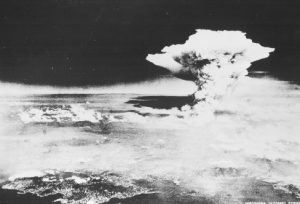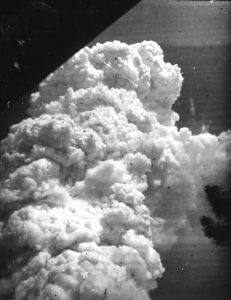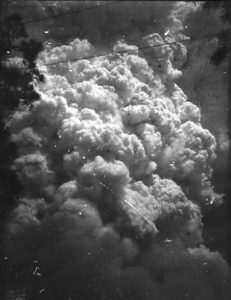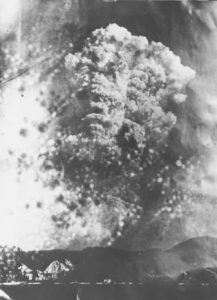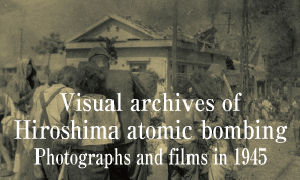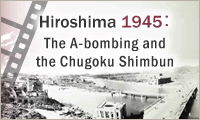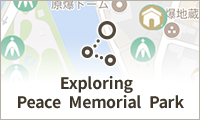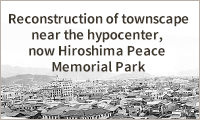Location where U.S. military aircraft photographed atomic cloud over Hiroshima identified as 9,000 meters above ground off Matsuyama
Feb. 22, 2000
Existence of original negatives of atomic cloud taken from the ground also confirmed
The Chugoku Shimbun identified the location where the U.S. military took the photo of the first atomic cloud in history following the atomic bombing of Hiroshima, as well as the circumstances at that time. On August 6, 1945, the bomb detonated in the sky approximately 580 meters above Saiku-machi in Hiroshima (now part of Ote-machi 1-chome, Naka Ward). Through researchers’ investigations and photographers’ testimonies, the newspaper also confirmed the negatives of the photos taken from the ground still exist, and how they were originally composed.
The atomic cloud was a combination of material blown upwards by the shock wave to the ground and smoke generated by the vaporization caused by a fireball, formed when the temperature of the burst point of uranium-235, a fissile material, reached several million degrees Celsius. According to the journey log of the Enola Gay, the cloud reached “more than 40,000 feet (12,200 meters) above the ground 45 minutes after the bomber dropped the atomic bomb.
A large panel of the photo, one of the representative shots by the U.S. military showing the enormous size of the cloud, is displayed in the corridor connecting the East building and the Peace Memorial Museum in Hiroshima City. Until now, it was unclear where and how the photo was taken. However, Michio Ide, a 58-year-old photographer and a member of the Materials Research Committee at Hiroshima Peace Memorial Museum who lives in Ushiroyama in Asa-cho, Asakita Ward, said: “It must have been photographed by a photo-reconnaissance aircraft at about 9,000 meters above Nogutsuna Island, off the coast of Matsuyama, four hours after the bombing.” He identified them based on verification work on a Cessna flight to search for the same angle as in the photos and take photos, as well as an examination of the telegram messages sent from the U.S. military to Washington.
The investigation summary created by the army and the navy teams four days after the bombing described the atomic cloud, formed immediately after the flash, as “milky white with a tinge of blue smoke rising up into the sky” when viewed from the ground.
“I ran into the building as soon as I saw the flash. I was blown down by the blast, but I made it to the second floor and took pictures from a window,” said 71-year-old Toshio Fukada of Yokogawa-cho 3-chome in Nishi Ward. He keeps the original negatives of his “August 6” photos. At that time, Mr. Fukada was a mobilized student working at the Hiroshima Army Ordnance Supply Depot, which is now the Kasumi Campus of Hiroshima University in Minami Ward. From the second-floor window of the army depot, about 2.7 kilometers from the hypocenter, he took four sequential photos with a small camera he had in his pocket. Based on the time of his action after the bombing and the shape of the cloud, they are believed to have been taken no later than 20 minutes after the explosion.
Masami Oki, 85, of Kanihara 1-chome in Kaita-cho, Aki-gun, Hiroshima Prefecture, was working in the pyrotechnics department at Kure Naval Arsenal in Wakaba-cho, Kure. He thought, “A magazine somewhere might have exploded,” and after about 40 minutes, he took just one photo of the uncanny cloud expanding in the western sky. The photo has been copied many times over the years and has even appeared in official publications, with either the land or the sea, or both, cropped.
▼Sequential photographs taken within 20 minutes after the explosion: These photos were printed from the original negatives kept by Mr. Fukada, who took them from the second-floor window of the Hiroshima Army Ordnance Supply Depot. It is presumed that they were taken in order from Photo (1). The object in the upper left corner of photos (1) and (2) is the eaves of the army depot. A pine tree, which stood in front of the building, is seen in photos (3) and (4). By lining up the four consequential photos, we can see how violently the atomic cloud went up.
(Originally published on February 22, 2000)

